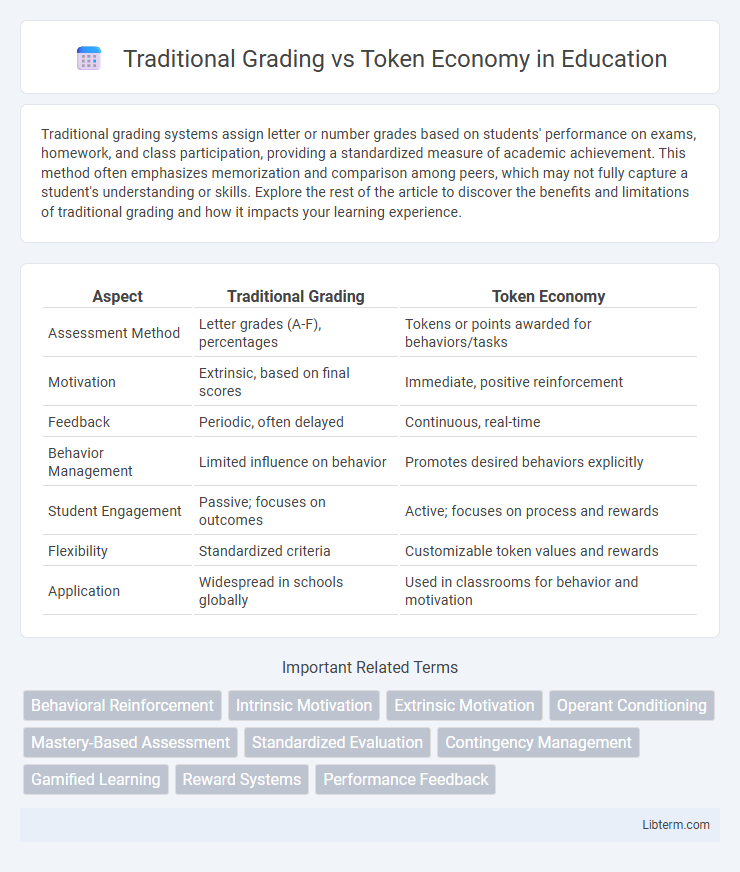Traditional grading systems assign letter or number grades based on students' performance on exams, homework, and class participation, providing a standardized measure of academic achievement. This method often emphasizes memorization and comparison among peers, which may not fully capture a student's understanding or skills. Explore the rest of the article to discover the benefits and limitations of traditional grading and how it impacts your learning experience.
Table of Comparison
| Aspect | Traditional Grading | Token Economy |
|---|---|---|
| Assessment Method | Letter grades (A-F), percentages | Tokens or points awarded for behaviors/tasks |
| Motivation | Extrinsic, based on final scores | Immediate, positive reinforcement |
| Feedback | Periodic, often delayed | Continuous, real-time |
| Behavior Management | Limited influence on behavior | Promotes desired behaviors explicitly |
| Student Engagement | Passive; focuses on outcomes | Active; focuses on process and rewards |
| Flexibility | Standardized criteria | Customizable token values and rewards |
| Application | Widespread in schools globally | Used in classrooms for behavior and motivation |
Introduction to Assessment Systems
Traditional grading systems assign numeric or letter grades based on academic performance, providing a standardized measure of student achievement. Token economies use behavioral reinforcement by awarding tokens for desired actions, which can be exchanged for rewards, emphasizing motivation and positive behavior. Both systems serve distinct roles in educational assessment, balancing evaluation of knowledge with encouragement of constructive habits.
Defining Traditional Grading
Traditional grading systems rely on numeric or letter scores to evaluate student performance, typically based on exams, quizzes, and assignments. These grades often aggregate scores into overall averages that determine academic standing and progression. This method emphasizes standardized assessment and comparison among students within a structured educational framework.
What is a Token Economy?
A token economy is a behavior management system that uses tokens as a form of positive reinforcement to encourage desirable behaviors. Tokens, which can be exchanged for rewards or privileges, help motivate individuals by providing immediate feedback and tangible incentives. This method contrasts with traditional grading by emphasizing ongoing behavioral progress rather than solely evaluating performance through numeric or letter grades.
Historical Context and Origins
Traditional grading originated in the late 19th century as a standardized method to assess student performance, heavily influenced by early educational reformers like Horace Mann. The token economy concept emerged in the mid-20th century, rooted in B.F. Skinner's operant conditioning principles and behaviorist psychology. While traditional grading emphasizes summative evaluation, token economies focus on positive reinforcement to shape behavior and learning outcomes.
Psychological Impact on Students
Traditional grading systems often induce anxiety and reduce intrinsic motivation by emphasizing external evaluation and fear of failure. Token economies foster positive behavioral reinforcement, increasing student engagement and self-regulation through immediate, tangible rewards. Psychological studies highlight that token economies promote a growth mindset, enhancing long-term motivation and academic resilience compared to conventional grading.
Motivation and Engagement Differences
Traditional grading often relies on external motivators such as scores and letters, which can decrease intrinsic motivation and limit student engagement. Token economies use positive reinforcement through earning tokens for desired behaviors, fostering sustained motivation and active participation. Research shows token systems enhance engagement by promoting consistent effort and creating a more interactive learning environment compared to conventional grading methods.
Practical Implementation Challenges
Traditional grading systems often face challenges such as time-consuming assessments and difficulties in providing immediate feedback, leading to reduced student motivation. Token economy systems require consistent reinforcement and clear criteria for token exchange, posing implementation complexities in diverse classroom settings. Balancing fairness and scalability remains a significant hurdle for educators integrating token economies into established grading frameworks.
Equity and Fairness Considerations
Traditional grading systems often perpetuate inequities by emphasizing standardized testing and rigid benchmarks that may not account for diverse learning styles or socio-economic backgrounds. Token economy approaches promote fairness through individualized reinforcement, allowing students to earn tokens for specific behaviors or achievements, which can reduce bias and motivate continuous improvement. By aligning rewards with personalized goals, token economies encourage equitable participation and provide a more inclusive measure of student progress than traditional grades.
Student Outcomes and Long-Term Effects
Traditional grading systems often emphasize fixed, cumulative assessments that may limit motivation and long-term retention, whereas token economy frameworks promote continuous reinforcement and positive behavior, resulting in improved student engagement and higher achievement rates. Research indicates token economies enhance intrinsic motivation and self-regulation, leading to sustained academic performance and better social skills over time. Long-term effects of token economies include increased student accountability and a growth mindset, which contribute to lifelong learning and resilience beyond the classroom.
Conclusion: Choosing the Right System
Choosing the right system between Traditional Grading and Token Economy depends on the specific educational goals and student needs. Traditional grading offers clear, standardized assessments that measure knowledge and achievement, while Token Economy systems promote motivation and behavioral improvements through immediate rewards. Implementing a hybrid approach can balance academic evaluation with positive reinforcement, optimizing student engagement and learning outcomes.
Traditional Grading Infographic

 libterm.com
libterm.com